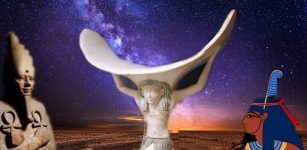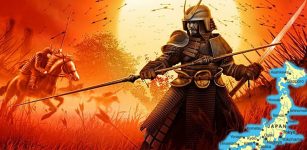Vikings And The Runic Calendar
AncientPages.com - The Vikings used a Runic calendar often written on parchment or carved onto staves of wood, bone, or horn. The year was divided into moon phases and the calendar reflected the seasons.
Sometimes, during summer it was difficult to observe the Moon because nights are so bright in Scandinavia that it is almost impossible to spot the Moon, especially in the northern parts.
Detail of a Runic Calendar, showing the three rows of symbols. Based on page 104 of F.E. Farwerck's Noord-Europese Mysteriën. Image credit: Wikipedia
The Vikings also observed how high the sun was in the sky because like all people they depended on weather for their survival. The year was divided into two equally long periods – summer and winter. A person’s age was counted in the number of winters he had lived.
The oldest discovered Runic calendar is the Nyköping staff from Sweden. Archaeologists and historians, think it is from the 13th century. Most Runic calendars are from the 16th and the 17th centuries.
Worm’s Norwegian runic calendar described in his book Fasti Danici dating back to 1643.
The drawing only shows the winter season lasting from 14 October to 13 April. The summer season on the other side of the bone from a whale or big fish was never copied, and both the pendant and the calendar have unfortunately been lost.
A typical Runic calendar consisted of several horizontal lines of symbols, one above the other. Special days like solstices, equinoxes, and celebrations were marked with additional lines of symbols. The Norse calendar system was also created using the Younger Futhark alphabet combined with three additional symbols, giving every day of the year a corresponding rune or combination of runes.
See also:
Runes: Facts And History About Odin’s Secret Language
Unravelling The Mystery Of The Ulfberht Sword – An Ancient Viking Artifact Far Ahead Of Its Time
The darkest period was named “Skammdegí” (the Dark Days) and the year’s brightest period “Nóttleysa”, meaning “insomnia” that many Scandinavians still experience today.
The winter months are Gormánuður, Ýlir, Mörsugur, Þorri, Goa and Einmánuður.
The summer months are Harpa, Skerpla, Sólmánuður, Heyannir, Tvímánuður and Haustmánuður.
Some years it may look as if it has been an additional 13th month to adjust the calendar: Silðemanuður (the Late Month).
The Runic calendar is a perpetual calendar which means it was designed to be valid for many years and allow the calculation of the day of the week for a given date in the future.
Copyright © AncientPages.com All rights reserved. This material may not be published, broadcast, rewritten or redistributed in whole or part without the express written permission of AncientPages.com
Expand for referencesReferences:
Thor News – The Viking Calendar
More From Ancient Pages
-
 Ancient Viking Age Music Recreated – This Is What It Sounds Like
Featured Stories | Sep 20, 2020
Ancient Viking Age Music Recreated – This Is What It Sounds Like
Featured Stories | Sep 20, 2020 -
 Puzzling McClelland Sherd – Undeciphered Inscription Could Be Early Bronze Age Writing
Artifacts | Mar 27, 2018
Puzzling McClelland Sherd – Undeciphered Inscription Could Be Early Bronze Age Writing
Artifacts | Mar 27, 2018 -
 The Black Obelisk Of Shalmaneser III – Great Assyrian Ruler
Artifacts | Dec 29, 2016
The Black Obelisk Of Shalmaneser III – Great Assyrian Ruler
Artifacts | Dec 29, 2016 -
 Shu: Egyptian God Of Air, Symbol Of Life-Giving Breath And The One Who Separates Heaven From Earth
Egyptian Mythology | Oct 23, 2020
Shu: Egyptian God Of Air, Symbol Of Life-Giving Breath And The One Who Separates Heaven From Earth
Egyptian Mythology | Oct 23, 2020 -
 Queen Marie Antoinette’s Silk Shoe Auctioned In Versailles
Artifacts | Nov 17, 2020
Queen Marie Antoinette’s Silk Shoe Auctioned In Versailles
Artifacts | Nov 17, 2020 -
 Chaneques: Mischievous Legendary Tricksters In Mexican Folklore
Featured Stories | Apr 14, 2020
Chaneques: Mischievous Legendary Tricksters In Mexican Folklore
Featured Stories | Apr 14, 2020 -
 Aztecs: Facts And History About The Ancient And Powerful Mesoamerican Civilization From Aztlán
Civilizations | Apr 10, 2017
Aztecs: Facts And History About The Ancient And Powerful Mesoamerican Civilization From Aztlán
Civilizations | Apr 10, 2017 -
 Intriguing Ket People – The Last Nomadic Hunter-Gatherers Of Siberia
Featured Stories | Nov 23, 2023
Intriguing Ket People – The Last Nomadic Hunter-Gatherers Of Siberia
Featured Stories | Nov 23, 2023 -
 Baths Of Caracalla: Italian Antique Thermae Complex For Leisure, Gossip, Business And Socialisation
Featured Stories | Dec 4, 2023
Baths Of Caracalla: Italian Antique Thermae Complex For Leisure, Gossip, Business And Socialisation
Featured Stories | Dec 4, 2023 -
 Mysterious Ancient Danube Stone Faces And The Fish Goddess Connection
Ancient and Unexplained Mysteries Library - Premium Content Preview | Dec 18, 2019
Mysterious Ancient Danube Stone Faces And The Fish Goddess Connection
Ancient and Unexplained Mysteries Library - Premium Content Preview | Dec 18, 2019 -
 Newspaper Rock Art: Ancient Indian Petroglyphs Tell 2,000-Year-Old Story Of Utah
Civilizations | Nov 28, 2018
Newspaper Rock Art: Ancient Indian Petroglyphs Tell 2,000-Year-Old Story Of Utah
Civilizations | Nov 28, 2018 -
 European Mythical Creatures Encountered In The Witcher Series
Featured Stories | Feb 4, 2020
European Mythical Creatures Encountered In The Witcher Series
Featured Stories | Feb 4, 2020 -
 Why Was Alexander A Great Military Genius?
Ancient History Facts | Oct 23, 2018
Why Was Alexander A Great Military Genius?
Ancient History Facts | Oct 23, 2018 -
 Ancient Great City Of Napata In The Kingdom Of Kush
Civilizations | Dec 30, 2015
Ancient Great City Of Napata In The Kingdom Of Kush
Civilizations | Dec 30, 2015 -
 Two Vikings From The Same Family Reunited After 1,000 Years
Archaeology | Jun 15, 2021
Two Vikings From The Same Family Reunited After 1,000 Years
Archaeology | Jun 15, 2021 -
 Large Ancient Statues And Artifact With Foreign Inscription Found In A Swamp In Michigan
Featured Stories | Oct 13, 2024
Large Ancient Statues And Artifact With Foreign Inscription Found In A Swamp In Michigan
Featured Stories | Oct 13, 2024 -
 Siberian Shigir Idol With Seven Faces Is The World’s Oldest Wooden Sculpture
Archaeology | Sep 1, 2015
Siberian Shigir Idol With Seven Faces Is The World’s Oldest Wooden Sculpture
Archaeology | Sep 1, 2015 -
 Pharaoh Apries – Was The Betrayed Egyptian King Murdered By His Own People?
Featured Stories | Jun 30, 2021
Pharaoh Apries – Was The Betrayed Egyptian King Murdered By His Own People?
Featured Stories | Jun 30, 2021 -
 Never-Before-Seen Strange 5,000-Year-Old Clay Figurine With A Tattooed Face And Bone Mask Found In Siberia
Archaeology | Oct 2, 2020
Never-Before-Seen Strange 5,000-Year-Old Clay Figurine With A Tattooed Face And Bone Mask Found In Siberia
Archaeology | Oct 2, 2020 -
 The Bushido Code: Centuries-Old Unwritten Code For Ideal Samurai Warrior
Featured Stories | Dec 26, 2016
The Bushido Code: Centuries-Old Unwritten Code For Ideal Samurai Warrior
Featured Stories | Dec 26, 2016




